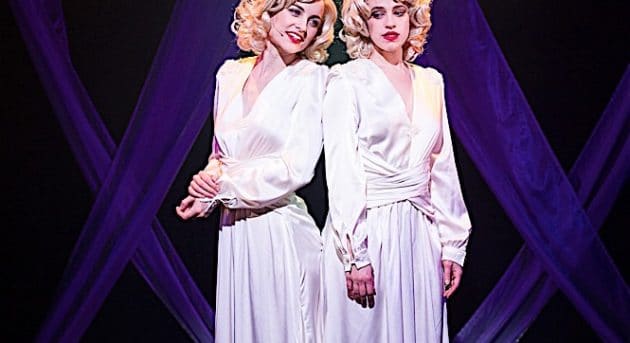Side Show – Hayes Theatre Co
Side Show invites you into the underbelly of a Depression-era circus where performers – generally people with disabilities, either real or faked – are placed on display to be gawked at. It can be brutal, but it is the only place they can find not only a job but also acceptance.
Amidst this particular group are the real-life Daisy and Violet Hilton (Laura Bunting and Kerrie Anne Greenland), conjoined twins who have been exploited since birth for their ‘condition’. The show, which opened on Broadway in 1997 and is making its Australian premiere at the Hayes Theatre, follows their journey from indentured circus acts to the highest paying vaudeville stars of the 1930s, and all the woes of romance and show business drama that come along the way.

Lauren Peters’ set introduces us to an intimate and confronting portrait of the sideshow with a circus tent backdrop. This allows for an intriguing unveiling of the circus acts during the first number but reduces the already small Hayes stage significantly, which makes it difficult for the first few scenes to achieve any kind of literal or figurative depth.
Still, director Richard Carroll lands on a few moments of anticipation and excitement in the first few scenes. He’s working with a book (by Bill Russell) that lacks clarity and keeps conflict at a low-stakes level despite the high-stakes nature of the show, and subsequently many of the larger ensemble scenes following the establishing numbers fall flat.
The show perks up once Daisy and Violet are head-hunted out of the circus for the vaudeville stage, however, the set again does a disservice to the action – now that the circus backdrop has been stripped away the stage is empty and scarce. Some of Carroll’s decisions don’t overcome this, with important dialogue being delivered with actors’ backs to the audience, obscuring the emotional impact of the drama – particularly egregious in the scenes leading up to Violet’s wedding. This aside, Carroll has a clear understanding of the heart of the show – the journey of two sisters yearning for their dreams to be fulfilled – and they are given most of the audience’s attention and time, thanks to the lighting and onstage blocking. We always know how they’re feeling, if not anyone else.
Bunting and Greenland have to, essentially, carry the whole show. They do it incredibly, together creating a touching and sisterly bond. Bunting’s Daisy is fierce and practical; she is flirtatious and alluring, but behind the confident charm has a clear understanding of her desperate situation and a longing for her dreams of fame and freedom to be fulfilled. Greenland’s Violet is the naïve and wishful counterpart to Bunting’s Daisy. Greenland longs desperately for love and normality removed from the spotlight, and delivers a nuanced and wounded performance. The women captivate and astound with their dynamic and controlled vocal performance, particularly in their two belting ballads ‘Who Will Love Me As I Am?’ and ‘I Will Never Leave You’.

The rest of the cast create a colourful and dynamic ensemble. Timothy Springs’ Jake – a protective guardian to the girls, whose understanding of what it means to be different is all too clear as a black man in America in the early 20th century – is a clear standout He delivers a guarded performance that allows a few beautiful moments of pain and desire come to the surface and delivers a stunning vocal performance to match.
Also notable are Berynn Schwerdt’s Sir, intimidating and knowing; Daniel Belle, who handles a careful dichotomy of a man in love but trapped by conformity as the twins’ manager Terry; and Gabriel Brown’s Buddy, Terry’s right-hand man, who is kind and desperately searching for the same love the girls are yearning for – and is denied it as much as they are.
Amy Campbell’s choreography creates a clear distinction between the liberated sideshow numbers and the refined and dazzlingly manufactured vaudeville acts. Henry Krieger’s score often relies on the impressive belting of the lead actresses, substituting sense for showiness, and Bill Russell’s lyrics are frequently empty. However, some of the group numbers, like ‘Cut Them Apart’, possess a haunting arrangement of harmonies that, with Conrad Hamill’s cohesive and commanding musical direction, deliver a powerful result.

Angela White’s stunning costumes, particularly for the Hilton sisters, grow with the action from tattered sideshow costumes to gorgeous vaudeville outfits that impress with their glamour and style. And through some clever engineering, the costumes make the sisters’ link (at the hip) authentic.
Though the narrative sometimes loses focus, what we’re left with, and what Carroll’s direction brings beautifully to the forefront, is a poignant story about two sisters, cast out from society, (either marvelled at or alienated) who long to be accepted for who they are. Through their journey, Side Show examines what it means to be different, and for anyone who has ever felt alone or out of place, Daisy and Violet’s signature refrain ‘Who Will Love me As I Am’, is one that resonates powerfully throughout the show.




